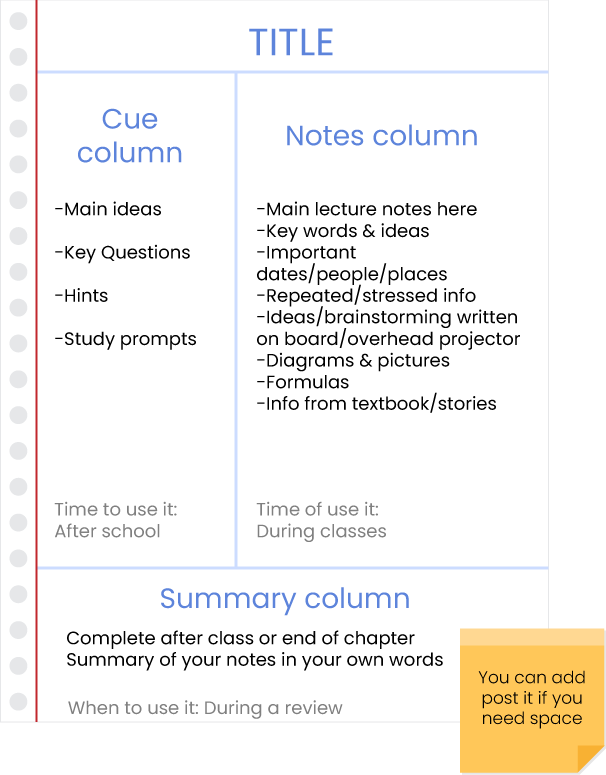We’ll guide you step by step and provide you with the ultimate template to boost your productivity and academic performance to 100%. Taking proper notes is crucial when studying. Through the Cornell Method, you will learn to keep your notes organized and well-structured, achieving better results when studying.
What is the Cornell Method?
The Cornell Note-Taking Method is a system created by Walter Pauk in the 1950s. This system uses a specific format to organize, present, and facilitate the later review of information.
This method can be used in school during a class, while conducting research, or when studying a book, making it a highly effective technique.
What is the Cornell Method for?
The goal of the Cornell Method is to allow users to analyze the data they write in their notebooks more easily. This is because the information will be organized and narrated in the person’s own words, making it easier to remember.
This aspect is particularly useful when conducting research, as it helps separate the user’s own ideas from those of another author.
By having a more efficient and organized note-taking system, students can better understand and retain the information, leading to more productive and effective study sessions.
How Does the Cornell Method Work?
This study method is very simple—you only need a pencil and a sheet of paper. To begin, divide the page into four sections, where each section will contain a different type of content. You should complete each section during class by taking notes and extracting the most important information.

Here’s how to divide the page and what each section should contain:
1. Header (Top Horizontal Margin)
In this section, write the title, subject name, date, and page number (key to keeping your notes organized).
2. Key Ideas (Left Margin)
This section is used to write down key questions, important points and concepts, unresolved doubts, and simple diagrams.
Ideally, use this section to review the topic on the same day you took the notes.
3. Class Notes (Main Space/Right Margin)
In this area, write the notes taken during the class or book reading. Use it to record all the relevant information, such as important phrases, references, lists, diagrams, formulas, blackboard notes, examples, and key concepts.
4. Summary (Bottom Horizontal Margin)
Use this section to create a brief summary that synthesizes all the content covered in class, providing a general overview of the key points.
Tips to Get the Most Out of Your Notes
✔ Avoid using long sentences.
✔ Use symbols or abbreviations.
✔ Review all the material after class and write key questions or ideas in the left column to later summarize in the bottom section.
✔ When studying, cover the right column and try to answer the key questions/ideas from the left column. This technique is very useful for learning and memorizing content.
✔ Within 24 hours of class, complete the Summary section by reviewing your notes and reflecting on the topic. This synthesis will be a great help when studying.
✔ Don’t wait too long to reread your notes and complete the sections—doing it early will help you better extract the main ideas and note any doubts that arise.
The 5 R’s of the Cornell Method
To guarantee better results, we recommend applying the Cornell Method along with the 5 R’s technique.
This technique consists of five steps that will help you improve comprehension and memory retention of all the information.
The 5 Steps Are:
1-Record
In the Notes column, record all significant ideas, data, facts, and key points from the class. Write it clearly and legibly to ensure you can reconstruct the full idea later.
2-Reduce
After class, create a synthesis of the topic in the Summary section, using short phrases and keywords. Summarizing helps clarify and reinforce what you learned that day, ensuring continuity and consolidation of memory.
3-Recite
After class, cover the Notes column and recite the topic aloud using your own words, guided by the key ideas in the left column.
4-Reflect
After reciting, reflect on the topic, ask yourself questions, and try to answer them to deepen your understanding.
5-Review
Review your notes for at least 10 minutes each day to better retain the content and be more productive when studying for exams.
When Should You Use the Cornell Method?
You can use this method for any subject or book at any time. No extra materials are needed—just a sheet of paper and a pencil.
Advantages of the Method
The Cornell Method is one of the most impactful study techniques in the academic world due to its many benefits. Some of them include:
1️⃣ Handwriting helps us retain information better since it slows us down and makes us think about what we’re writing.
2️⃣ Increases concentration and helps you stay focused during class, significantly improving study productivity.
3️⃣ Encourages active listening
To take notes, you must not only focus but also engage in active listening—helping you absorb the information, recognize key ideas, and identify what you understand and what you don’t.
4️⃣ Helps structure and organize content, providing a framework for understanding, reviewing, and learning.
5️⃣ Can be applied to any subject, regardless of difficulty or situation, making it highly versatile.
6️⃣ Develops other essential skills, such as organization and active listening, which are crucial in the professional world.
The Cornell Method not only helps you take notes more efficiently but also improves your comprehension, organization, and memorization of the content.
Thanks to its clear structure and active approach, it becomes an ideal tool to boost academic performance. Additionally, it allows you to make the most of your study hours.
If you want to keep exploring better study methods, we invite you to discover another highly effective technique: the Pomodoro Technique. Find out on our blog how to apply it to maintain focus and study with fewer distractions.



